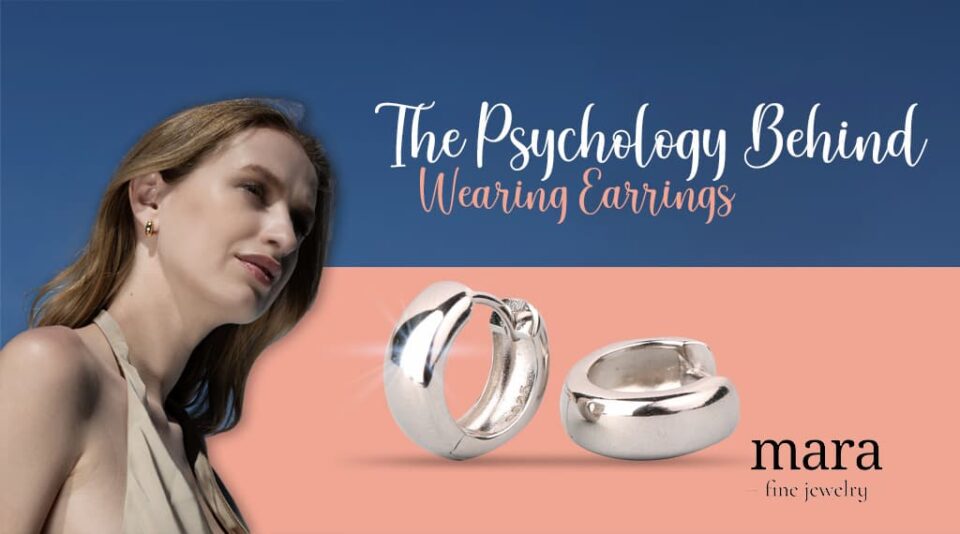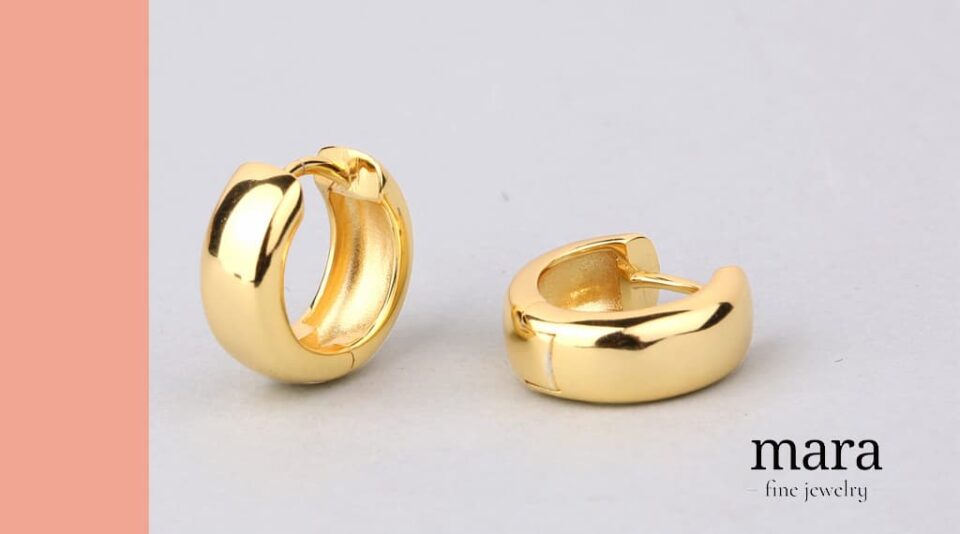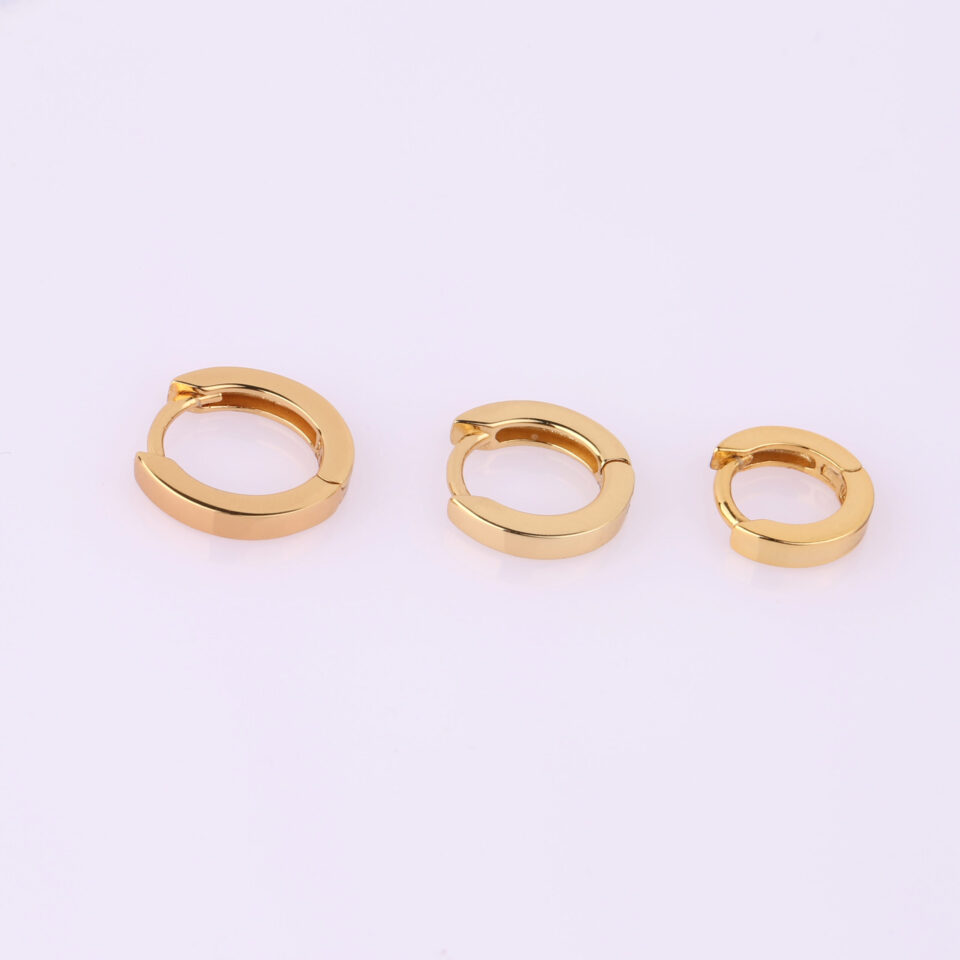
- by Mara
- April 28, 2024
- Blog, Trends and Styles
- Comments:3
The psychology behind earrings offers a fascinating insight into how our choice of adornment can reflect our personality, social status, and even our psychological state. Adorning oneself with earrings is not just about accessorizing; it’s a profound form of self-expression deeply intertwined with our psychology and culture.
Table of Contents
ToggleIn this blog, we aim to explore the psychological implications of choosing and wearing different types of earrings, shedding light on how they influence our perceptions of ourselves and others.
We will cover what earrings have to do with personality, how earrings can influence your mood, the social and cultural implications of wearing earrings, how different life stages influence the choice of earrings you make, the psychological comfort earrings can give, why earrings are a form of nonverbal communication and their historical significance.
Earrings and Personality
Your choice of earrings expresses your personality traits and individuality. Your earrings’ style, materials, and sizes tell people about your tastes, interests, and values. For instance, if you like wearing bold and statement earrings, they indicate a confident and outgoing personality. Minimalist and understated designs can suggest a preference for simplicity and elegance.
Earrings showcase your style preference. If you love vintage fashion, you may opt for retro-inspired earrings. You will choose a more sleek and modern design if you like a more contemporary style.
Your earrings hold symbolic meaning for you. They represent your cultural heritage, spiritual beliefs, or important life events. You might wear earrings featuring luck, love, or protection symbols as a personal talisman.
People who love a complete and harmonizing look usually pay close attention to details. They carefully select their earrings based on their face, hair color, and outfit. They want to look their best.
When someone always wears different earrings, they show different parts of their personality based on the current situation. This shows that such people are versatile and can adapt their style.
Earrings and Mood
Wearing particular earrings indicates or alters the wearer’s mood. For example, bright colors are often worn to uplift spirits. People want to show their good mood through their jewelry.
In color psychology, a branch of psychology that studies how colors affect human behavior and emotions, it is believed that certain colors can evoke specific emotions. For example, bright and vibrant colors like red or yellow can create a sense of energy and positivity, making you feel more alert and cheerful. Softer hues like pastel blues or greens can promote calmness and tranquillity, helping you relax and unwind. Therefore, the color of your earrings significantly impacts your mood and how others perceive you.
Design and style influence mood. You may wear delicate, dainty earrings to feel feminine and elegant. You wear whimsical or playful earring designs to uplift your spirit and have fun.
Choosing and wearing earrings you love and feel confident in improves your mood. The perfect pair, matched with your outfit, boosts your self-esteem and creates a sense of empowerment. This act of self-expression is a powerful tool that can make you feel more confident and in control.
It is essential to be mindful while selecting earrings. Earrings significantly influence your mood and contribute to a more positive mood. When chosen based on one’s personality, they enhance self-expression and satisfaction.
Social and Cultural Implications of Wearing Earrings
Earrings have different meanings, such as social and cultural implications. They communicate things like cultural identity, social belonging, or non-conformity.
Earrings have a rich history of social and cultural significance and are fashion accessories. Throughout history and across cultures, wearing earrings has symbolized status and wealth. Elaborate and ornate earrings were once the domain of aristocrats and royalty, symbolizing their privileged societal position. Even today, designer or high-end earrings can still signal affluence and status. The choice of material for your earrings speaks volumes about your wealth and status in society.
Your cultural and ethnic identity influences your design and style preferences. You may choose earrings based on your identity and belonging. For example, hoop earrings are commonly associated with Romani culture, and jhumka earrings are traditionally worn in India and South Asia. These cultural associations are about fashion and powerful symbols of identity and belonging, and wearing them expresses and celebrates one’s cultural heritage.
Earrings are worn as symbols of faith and devotion. Based on your religious and spiritual practices, you may choose earrings according to your beliefs. They are worn as expressions of religious identity or as talismans for protection and blessings.
Many individuals use earring styles to show non-conformity to gender roles or stereotypes and encourage others to show their fashion preferences and express themselves in their ways.
There are specific social norms that individuals need to abide by. There are implicit or explicit expectations regarding wearing earrings in specific professional or social contexts. Certain events dictate appropriate styles or prohibit wearing earrings altogether.
Earrings and Life Stages
Earrings mark significant life stages, like graduation or marriage. In some cultures, ear piercing is an important tradition for infants and young children. It symbolizes cultural rituals, protection, blessing, or cultural identity. This tradition is usually performed shortly after birth or during early childhood. Infants or young children commonly wear simple studs or small hoops. These designs are chosen for their practicality and ease of care.
Ear piercing is seen as a rite of passage or symbolic gesture of growing up for individuals entering adolescence. They will experiment with different earring styles and trends as they explore their personal identity and express their individuality through fashion.
In adulthood, many adults choose earrings that reflect their personality, taste, and lifestyle. Depending on the occasion, their personality, and style preference, they choose classic studs for everyday wear, statement earrings for special occasions, or symbolic pieces with personal significance. This evolution in the choice of earrings reflects the individual’s personal growth and changing priorities. For example, young professionals start with simple, understated earrings to project a professional image, but as they gain confidence and experience, they start experimenting with bolder, more expressive designs.
The bridal attire commonly includes earrings. They symbolize beauty, elegance, and femininity. In some cultures, the earrings hold traditional significance for brides, representing marital status, fertility, or cultural heritage. After getting married, women continue to wear those earrings as sentimental reminders of the wedding day and the commitment to a lifelong partnership.
Mothers-to-be or new mothers wear specific earring styles to symbolize maternal love and nurturing. They are gifted to celebrate the birth of a child or as expressions of appreciation for mothers’ sacrifice and dedication.
In later life, earrings hold more of a sentimental value, representing memories, relationships, or personal achievements. They serve as cherished heirlooms passed down through generations, connecting different family members across time.

Psychological Comfort and Earrings
Particular earrings provide psychological comfort, like security or a cherished keepsake. Wearing earrings that align with personal style and preferences expresses one’s identity and showcases one’s unique personality. This act of self-expression boosts one’s confidence, provides a sense of empowerment, and reinforces a positive self-concept.
Earrings make people feel more attractive and put together as they complement facial features, hairstyles, and outfits. This leads to increased self-esteem and greater satisfaction with one’s appearance.
Earrings hold sentimental significance as they are a gift from a loved one, an heirloom, or souvenirs from a meaningful experience. Wearing such emotionally significant earrings evokes positive memories, feelings of connection, and a sense of continuity with the past. This provides comfort during challenging times or periods of change.
Wearing earrings makes you feel complete and secure. The act of putting on the earrings signals the start of the day and contributes to a sense of readiness and preparedness for what the day brings. Similarly, removing earrings at the end of the day signifies the transition to relaxation and unwinding. These rituals help individuals feel secure as they keep repeating the same ritual for the comfort of their minds.
Earrings have a therapeutic value. Some individuals find comfort in the tactile experience of handling earrings. They like the weight of earrings against the earlobes or the act of clasping and unclasping earring backs. This sensory stimulation has a calming effect and serves as a form of tactile therapy, helping to alleviate stress, anxiety, or restlessness. It significantly helps people with ADHD to concentrate on their matters.
Earrings as a Form of Non-Verbal Communication
Earrings serve as a form of non-verbal communication, conveying messages about the wearer without words. Earrings help to understand a person better. By wearing earrings, an individual exposes a part of their personality, beliefs, and emotional status. It shows your great appreciation and love for that person if the earrings were a gift from a loved one. People will know how you’re feeling if you change the color of your earrings based on your mood. It reflects your social status and identity if you choose to change your earring style based on your outfits and occasion.
Earrings serve as a versatile and expressive form of non-verbal communication, allowing individuals to convey aspects of their identity, emotions, and social connections through their choice of adornment. Whether through style, symbolism, or sentiment, earrings play a significant role in shaping interpersonal interactions and communicating messages to the world with no words.
Historical Significance of Earrings
Earrings have held significant cultural and historical importance across various civilizations throughout history. They served as more than just decorative accessories. In ancient Egypt, earrings were fashion statements and symbolized wealth and status. Men and women adorned themselves with intricate earrings, often made of precious metals and gemstones. They also held significant symbolic value, with some designs featuring symbols associated with deities like the sun god Ra or the goddess Hathor.
Similarly, in ancient Rome, earrings were status symbols. The materials and designs used depended on one’s social rank; for example, the elite used gold and precious gems. Another meaning of earrings is in marital rituals. Roman brides often received earrings as wedding gifts to symbolize their new status as married women.
Other cultures, like the Native American tribes, have historically used earrings to signify tribal affiliations, religious beliefs, and even political allegiance. In some cases, earrings were worn as protective talismans, believed to ward off evil spirits or bring good fortune.
Over time, earrings became associated with femininity and sensuality. Different cultures even ascribed various meanings to earrings in terms of gender roles and expressions of beauty. In medieval Europe, earrings were primarily worn by women of high social standing. At the same time, men’s fashion tended to be more reserved in this regard.
Conclusion
The psychology of earrings allows for various interpretations of why people wear earrings. It shows or influences one’s personality. You’ll wear bold statement pieces that you feel comfortable in if you want to feel confident. You’ll wear more delicate studs if you want to show your femininity.
Earrings influence your mood. Bright colors are good for a more positive and uplifting mood. Culture plays a big role in wearing earrings, as cultural and social beliefs influence one’s earring design preferences. Earrings are a symbolic statement of an individual’s cultural and social beliefs.
Different life stages bring different preferences and meanings to earrings. It doesn’t matter if you were just born, are getting married, or are wearing earrings in later life; earrings will always have a specific meaning, such as traditional rituals, wearing an heirloom, or as a symbolic meaning of marriage.
Earrings bring psychological comfort and have been used as a form of non-verbal communication for centuries. Historically, earrings have been used to communicate one’s wealth, status, talismans, tribal allegiance, and marital status.














[…] can reflect your personality and influence others’ perceptions, read our article on “Psychology Behind Wearing Earrings“. […]
[…] Your style and preferences are important when making earring choices. Guidelines are helpful, but feel free to break the rules and experiment with different styles that speak to you and make you feel comfortable and confident. If you love classic pearls, bold statement earrings, or minimalist studs, choose the earrings that make you feel confident and reflect who you are. For a deeper understanding of how your earring choices influence and reflect your personality and emotions, explore our article on the psychology behind wearing earrings. […]
[…] about the psychological impact and the broader implications of this trend, explore our “Psychology Behind Wearing Earrings” blog, which covers how personal style choices can influence perception and […]